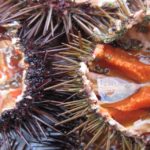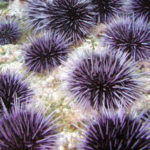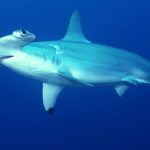Sea otters
 Sea otter can be found only in the tropical and temperate coasts of South America, washed by the waters of the Pacific Ocean. Nature has endowed this very small marine mammal with a living mind and amazing flexibility. Observe the behavior of this little animal is a pleasure. It is a rather reserved and timid creature spending two-thirds of its life in the sea. Diving to a depth of 50 meters, the sea otter extracts crabs, sea urchins, mollusks and catches small fishes.
Sea otter can be found only in the tropical and temperate coasts of South America, washed by the waters of the Pacific Ocean. Nature has endowed this very small marine mammal with a living mind and amazing flexibility. Observe the behavior of this little animal is a pleasure. It is a rather reserved and timid creature spending two-thirds of its life in the sea. Diving to a depth of 50 meters, the sea otter extracts crabs, sea urchins, mollusks and catches small fishes.
But she does not mind and eat fruit from the coastal trees. In pursuit of its prey, a predator can retire 500 meters from the sea coast, although it feels awkward and helpless on land. After catching his breakfast at the bottom, the animal starts eating, turning on his back and laying his prey on his stomach. Despite the fact that the otter has very short forelegs and very small fingers, it straightens with amazing agility with the needles of sea urchins, gnawing through the strong shell with sharp teeth. Sea otters do not use stones for mining, as their river relatives do.
During the meal, animals very often turn over in the water, but the food remains in an amazing way in the folds of the abdomen. The otter takes his breakfast lightly with his paws, not letting him fall. This stunt animal will give odds to any magician. Fresh water is needed, they do not go far from its source. However, their body is arranged in such a way that they can completely fill the need with salt water. Watching these interesting animals tumbling in the water, one might think that they are frolicking. However, such overturning is vital. Thus, animals clean their fur so that it retains heat and protects them from freezing. The way sleep of these little animals can not but cause tenderness and a feeling of tenderness.
Adult otters sleep side by side, holding their little paws for each other. And the kids settle on their parents’ chest, tucking their tiny muzzles into the chin of their mother or father. Is not that so, like a family idyll. However, this behavior is caused only by fear that a member of the family can carry away the current far. If the sea otter has not yet found a pair, at night it dresses in a peculiar cocoon, diving and wrapping in algae. In such a cocoon, the animal can rest assured that it will wake up at the same place, and the current does not pose a danger to it.
Intelligent sea otters are often tried to tame and use in representations. However, after learning the number and getting a reward for it, the animal begins to improve it in its own way, and often the trick does not meet the wishes of the trainer. Master improvisation, sea otters have many interesting features. People only need to look at them and pay less attention to the value of the fur of these small animals.



























